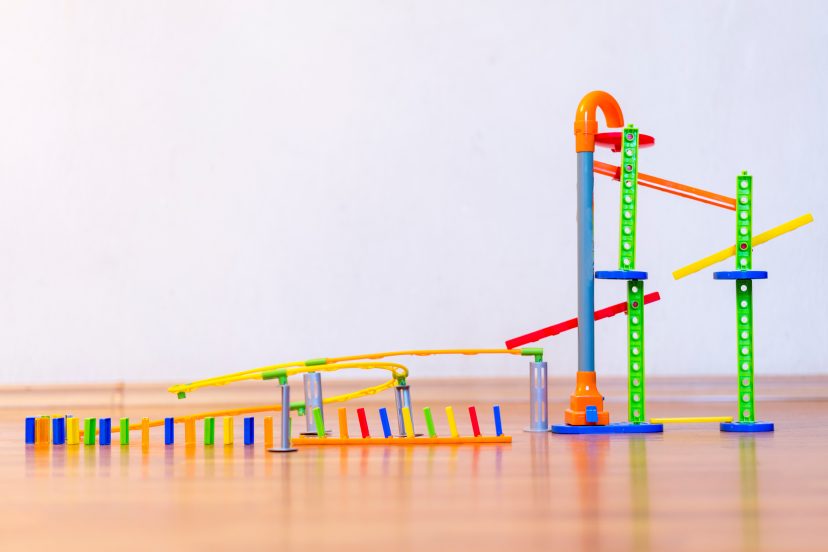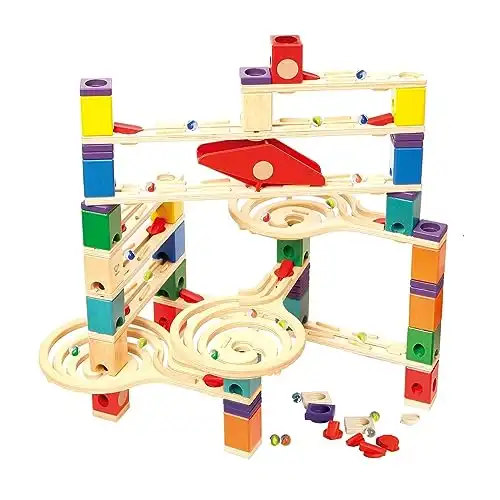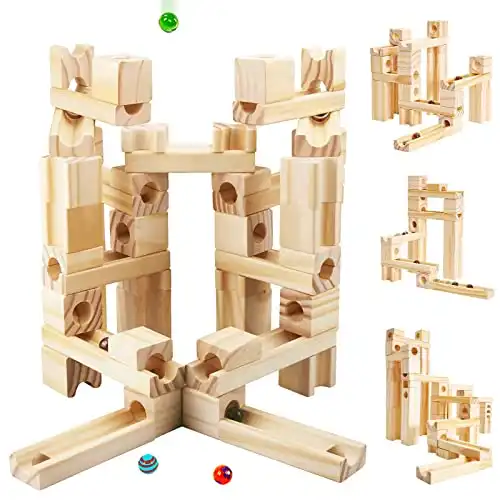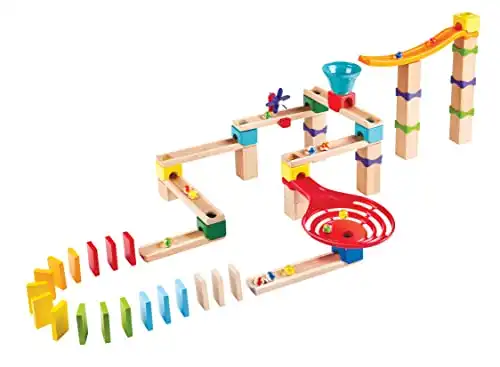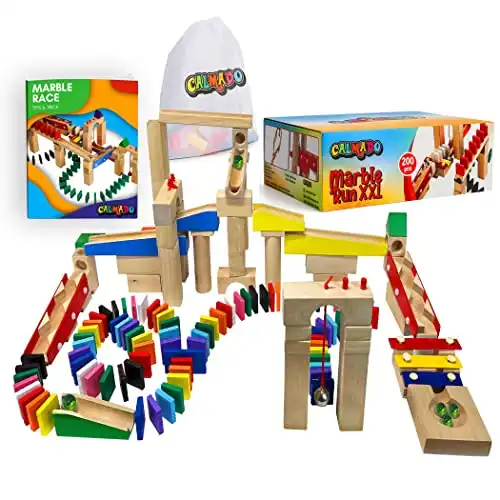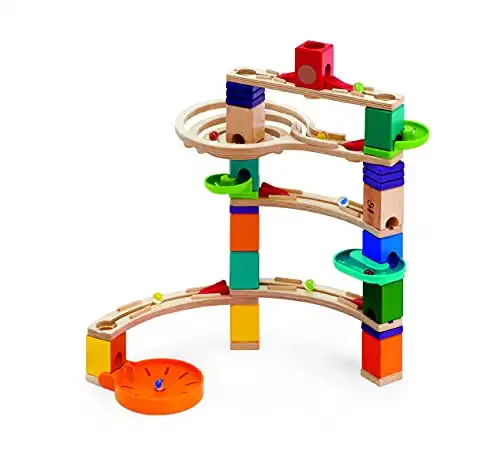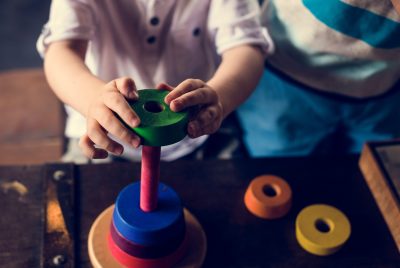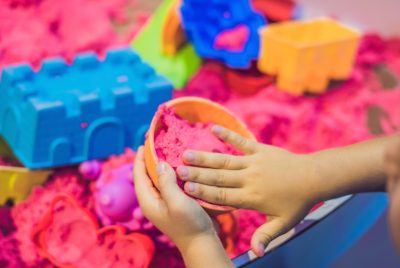Wooden Marble Runs – Learning Through Creative Play
Have you ever watched a child’s eyes light up at the sight of a wooden marble run? The anticipation as they place the marble at the top, the joy in the sound of the marble clinking down the tracks, and the eager rush to start it all over again once it reaches the bottom.
It’s not just fun; it’s a whole world of learning unfolding before their eyes. And when that marble run is made of wood, there’s an added layer of warmth and natural beauty to the experience.
The Magic of Wooden Toys
Wooden toys, by their very nature, have a timeless appeal. They are strong, good for the environment, and bring back memories for adults while also sparking interest in children. Wooden marble runs, in particular, stand out as both beautiful and functional pieces.
The warmth and natural texture of wood offer a sensory experience that plastic toys cannot. This tactile engagement can stimulate cognitive development in young children as they explore and handle the wooden pieces.
Why Wooden Marble Runs Engage Children and Adults Alike
The joy of wooden marble runs lies in their simplicity and the complex systems they create. Watching a marble roll through twist and turns offers endless hours of fun. But beyond the immediate visual and tactile appeal, marble runs engage the mind. They are puzzles to solve, physics lessons in real time, and a canvas for creativity.
Kids love watching marbles roll and building new tracks. Each run is an experiment, a challenge to make the marble go faster, take longer routes, or achieve fun stunts.
Parents enjoy playing with children and feeling proud when they help them succeed in a fun activity. Moreover, the design and construction of a wood marble run can be a calming and rewarding hobby.
The Benefits Of A Wooden Marble Run
Wooden marble runs are not just toys; they’re clever construction toys that blend the joy of play with learning. Now let’s explore the educational advantages of these toys and how they can help your child’s development.
Enhancing Fine Motor Skills
The handling of small marbles and the careful placement of the tracks demand precision and control. As children pick up, position, and adjust the pieces, they’re using and strengthening the small muscles in their hands and fingers. This fine motor skill development is crucial, laying the ground work for writing, drawing and hand eye coordination.
Boosting Problem Solving and Critical Thinking
A wood marble run presents children with a series of challenges and puzzles to solve. From figuring out how to get the marble from start to finish, to finding out why a marble stops mid way. They encourage children to think logically and experiment with solutions.
Trying different things helps improve problem solving skills. It also teaches kids about the scientific method. The scientific method involves making guesses, testing them, watching what happens, and drawing conclusions.
Help Develop An Understanding Gravity and Physics
At its core, play with a marble run is a lesson in basic physics. Children can see the effects of gravity as the marble races down the tracks.
They learn about speed, momentum, and angles, gaining knowledge that later forms the foundation for more formal physics education.
Watching the marbles roll down and up slopes helps kids understand kinetic and potential energy concepts.
.
Encouraging Creativity and Imagination
Unlike many toys that come with a fixed set of rules, wooden marble runs offer endless possibilities for change. Each setup of this construction toy can be unique, allowing children to tap into their creativity and imagination. They’re not just building tracks; they’re creating entire worlds for their marbles to explore.
Promoting Spatial Awareness and Planning
Assembling a marble run requires an understanding of space, direction, and sequence. Children learn to anticipate the path of the marble, planning their construction to ensure a successful run. This process enhances spatial reasoning skills, crucial for mathematics, science, and everyday tasks. It also introduces the concept of planning and sequencing, skills that are valuable in academic settings and in life.
Fostering Perseverance and Resilience
Building a complex marble run isn’t always easy. Children will often face struggles; pieces that don’t fit, structures that collapse, and marbles that get stuck. Each attempt provides a lesson in patience and determination, qualities that extend into all areas of life.
The Social and Emotional Learning (SEL) Aspect Of Marble Runs
Wooden marble runs not only help with thinking and moving, but also teach important social and emotional skills.
Social and emotional learning (SEL) is about understanding and controlling emotions, setting goals, showing empathy, building relationships, and making good choices.
Enhancing Social Skills and Cooperation
Children playing with wooden marble runs together explore and solve problems on a shared journey of discovery. This teamwork requires talking and working together to plan the marble run, assign jobs, and solve issues as a group.
Children learn to listen to others, appreciate different view points, and work together towards a shared goal through these interactions. Such experiences are essential for building healthy, positive relationships in all areas of life.
Developing Emotional Intelligence
Playing with marble runs can help kids become more emotionally intelligent. This means they can learn to understand and control their own emotions. They can also learn to recognize and handle the emotions of other people. When a marble run doesn’t work, it’s a chance to practice controlling emotions like disappointment or anger.
Encouraging Sharing and Turn-taking
Wooden marble runs often require sharing and turn taking, especially when resources are limited, or many hands are involved in the play. Children learn to negotiate turns and share pieces, which are crucial social skills.
Playing together helps kids learn fairness and respect. It also shows them that working as a team makes the game more fun for everyone.
Building Confidence and Self-esteem
The accomplishment of finishing a marble run can be a significant confidence booster. Children feel a sense of pride and achievement when they see their creations work as intended. This achievement increases their confidence and motivates them to try new things. They become confident in their abilities to solve problems and make their ideas a reality.
Integrating Wooden Marble Runs into Learning Activities
Using wooden marble runs in learning activities can make a child’s education more fun and interactive. Children can use these building toys for fun and educational activities, which makes learning hands on and enjoyable
Below, we explore how wooden marble runs can be used to facilitate learning across different areas, providing practical ideas for parents, educators, and caregivers.
Enhancing STEM Learning
Simple Physics Experiments
Wooden marble runs are excellent tools for introducing children to basic physics concepts such as gravity, force, and motion. By adjusting the angles and heights of the tracks, children can observe how these changes affect the speed and distance of the marble.
Engineering Challenges
Encourage children to design marble runs that meet specific criteria, such as a course that takes the longest time for a marble to complete or one that includes a loop-the-loop. These challenges require children to think like engineers, planning, testing and refining their designs based on the outcomes.
Supporting Math Skills
Use marble runs to practice counting and basic math. Ask children to count the number of pieces used to build the track or the number of times a marble loops around a particular section.
You can also measure how long it takes a marble to finish a course. Compare different setups to learn about speed differences.
Developing Language and Literacy
Incorporate storytelling into marble run activities by creating stories about the journey of a marble through the run. Ask children to describe the marble’s adventures, including the challenges it faces and how it overcomes them. This activity can enhance narrative skills and expand vocabulary as children describe their marble run in detail.
Promoting Social and Emotional Learning
Working together to build a marble run promotes teamwork, communication, and social skills. Encourage group projects where children must work together to design and construct a marble run. Playing together helps create a sense of belonging and community, while also teaching important lessons in compromise and leadership.
DIY Wooden Marble Run Project
Creating a wooden marble run can be a fun project and will give you a unique toy. It can also aid in learning and development. DIY projects can boost creativity, problem solving skills, and knowledge of physics and engineering.
Here’s a closer look at the benefits and tips to start your own DIY wooden marble run project.
Benefits of Building Your Own Wooden Marble Run
Make It Personal
A significant advantage of DIY wooden marble runs is the ability to adjust the design to fit specific educational goals. You can tailor the difficulty, themes, and size to the child’s age and interests, making it an ideal learning toy.
Hands on Learning Experience
The process of designing and building a marble run provides a hands on learning experience in physics and engineering. It encourages children and adults alike to think about spatial relationships, gravity and motion.
Creativity and Imagination
From planning to execution, building a wooden marble run from scratch sparks creativity and imagination. It transforms abstract concepts into real results, allowing kids to experiment with various designs and decorations.
Problem Solving Skills
The trial and error involved in making sure the marble runs smoothly from start to finish enhance problem solving skills. Adjusting angles, fixing jams, and optimizing speeds require critical thinking and adaptability.
Bonding Activity
Building a DIY wooden marble run can be a fantastic bonding activity for families or groups of friends. It encourages teamwork, communication, and the sharing of ideas.
Tips for a Successful DIY Wooden Marble Run Project
Start with a Plan
Before you start cutting wood or making holes, sketch out your design. Consider the size of the marbles and any specific features you want to include. Planning helps anticipate challenges and ensures that all parts fit together properly.
Choose the Right Materials
Select durable, high quality wood that can withstand repeated use. Softwoods like pine are easy to work with. Ensure all materials, including paints and finishes, are non toxic and safe for children.
Safety First
When building a marble run, make sure all tracks are smooth. Round the edges and make the structure stable enough to prevent breaking during play. Always watch young children during both the building and playing phases to ensure safety.
Keep It Flexible
Construct your marble track with versatility as a key consideration. Creating parts that can be changed or added to keeps the toy interesting for different ages.
Test and Iterate
After completing a section of your marble run, test it with a marble. This quick feedback helps you make changes and improvements, making the final product work better and more fun.
Closing Thoughts From Me
Wooden marble runs are more than just construction toys; they are tools for learning and development, wrapped up in the guise of play. They offer an engaging way to explore physics, enhance fine motor skills, and spark creativity.
By choosing the right marble run for your child and integrating it into learning activities, you are providing a valuable educational experience. By choosing a sustainable toy like a wooden marble run, you are making playtime not only fun but also meaningful.
FAQs
What age is appropriate for a wooden marble run? Wooden marble runs are suitable for children as young as 3 years old, with simpler designs. We recommend more complex sets for older children, typically 6 years and up.
How can I ensure the safety of a wooden marble run? Look for non toxic sets with smooth edges and securely fastened parts to avoid any risk of injury.
Can a wooden marble run game help with school readiness? Yes, they can help kids learn important skills for school, like problem solving and basic STEM concepts.
Are there eco friendly wood marble runs? Many wooden marble runs are eco friendly and designed to last, reducing the need for frequent replacements.
How can I make a DIY wood marble run safer for my child? Ensure all pieces are well sanded and secure all parts firmly to ensure the structure is stable during play.

